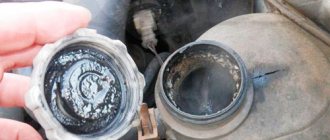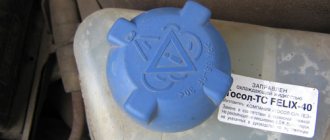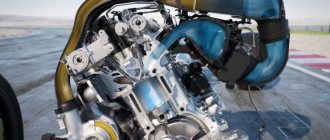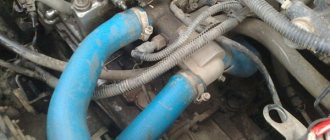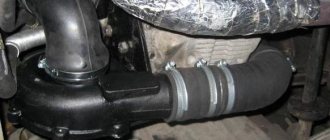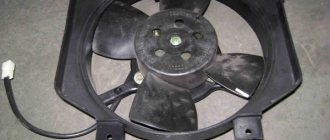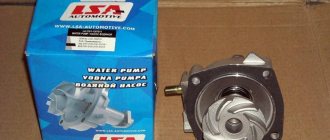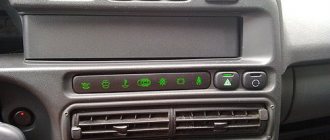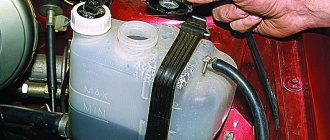The presence of air in the car's cooling system causes problems with engine overheating and ineffective operation of the interior heater. This article will present 4 methods by which it will become clear how to expel air from the cooling system of a VAZ 2114. The methods for solving the problem described in this article can be used on the entire family of first and second Samaras.
Useful video:
How to remove air from the stove of a VAZ 2114
How to remove an air lock?
An air lock in the engine cooling system is one of the main reasons for the engine taking a long time to warm up to operating temperature. Therefore, every driver should be interested in removing air lock from the cooling system of his car.
How to properly remove an air lock from the cooling system?
According to the law of physics, air accumulates in the highest place. In a car, the highest link in the coolant chain is the throttle body. That is why the air must be removed from there. There are several ways to get rid of an air lock. Here's the first one from the bottom:
If you have a 1.6 liter engine. then the first thing we do is remove the plastic cover on the engine - unscrew the cover on the engine to fill the oil, and then pull out the entire cover. It is seated on rubber seals. After removing this plastic screen, screw the oil cap back on to prevent dirt from getting into the crankcase.
- We find the heating pipes for the throttle assembly (there are 2 of them), see the figure. Pick up any phone.
- Next, unscrew the cap of the expansion tank (coolant reservoir) and cover the neck of the tank with a clean rag.
- We begin to blow into the tank with liquid. We blow until all the air comes out of the hose and antifreeze flows out.
- We quickly put the tube back on and tighten it with a clamp so that no air gets in.
(It is worth noting that depending on the tube that you removed, antifreeze may leak from both the tube and the fitting from which the tube was removed).
The second method of removing air from the cooling system is less perverted. There is no need to blow anything here:
- Warm up the engine to operating temperature.
- Warming up, turn off the engine.
- The expansion tank cap does NOT need to be unscrewed.
- As in the first method, unscrew the clamp of the coolant pipe on the throttle assembly.
- Having removed the heating pipe of the throttle assembly, release the air, and after the antifreeze begins to flow out, immediately put it back on the fitting and secure it well with a clamp.
But be careful and careful! Don't forget that the coolant temperature is approximately 90 degrees.
There is also a simpler, but less effective way to eliminate an air lock:
- We drive up a steep hill so that the radiator cap becomes the highest point of the cooling system.
- Unscrew the expansion tank cap and the radiator cap.
- Let the car warm up to operating temperature.
- Then we accelerate several times and at the same time add coolant into the barrel.
Do this until bubbles stop appearing.
How to remove an air lock on a VAZ with electronic (e-gas)?
Since there is no throttle valve cooling system, you need to bypass this unit. Here you can also set the car up.
I hope that these three methods will help you solve the problem, and that you have found all the answers to your questions on the topic “How to get rid of an airlock?”
Added: January 23, 2012 08:10
Comrade's car Kalina 1.6 8kl. Air appeared in the stove after he replaced the stove radiator with a Luzar (old leak) and filled in antifreeze instead of antifreeze. Now the water is bubbling in the stove and the car is clanking. What do you recommend, we’ve already tried everything, they installed a tee so that antifreeze flows straight into the stove from the head, they drilled a hole in the radiator and stuck the bolts in, you let out the air and then plug it. All that remains is to replace the heater radiator with another one and replace the antifreeze with antifreeze back. _________________ vaz2106 - vaz 21093 - vaz 21103, 99 onwards - vaz 21093, 97 onwards - Kalina Hatch 2007 onwards
8 years on the forum
Car: VAZ-21124; Kalina sedan 1.6 8cl; Priora Hatch
Added: January 23, 2012 08:21
So what's the problem? Can't you get the air out of the cooling system or does it reappear after you get it out?
12 years on the forum
Added: January 23, 2012 09:21
drive1 car facing up, loosen the expansion tank cap, and four thousand turns until the fan turns on. There will be an arrival, we recently pumped the viburnum ourselves
10 years on the forum
From: Penza region
Added: January 23, 2012 09:39
The problem is that air appears again, and very quickly. Face up is the very first thing we tried, I accelerated for 20 to 30 minutes, it didn’t help. _________________ vaz2106 - vaz 21093 - vaz 21103, 99 onwards - vaz 21093, 97 onwards - Kalina Hatch 2007 onwards
Acura Audi BMW Cadillac Chevrolet Chrysler Citroen Daewoo Dodge Fiat Ford GMC Honda Hummer Hyundai Infiniti Isuzu Jaguar Jeep Kia Land Rover Lexus Mazda Mercedes Mitsubishi Nissan Opel Peugeot Porsche Renault Rover Saab Seat Skoda Ssang Yong Subaru Suzuki Toyota Volvo VW
How to remove air from the cooling system of a VAZ
How long does it take for a car to warm up to operating temperature? You probably have an air lock in the cooling system. The phenomenon is quite common and unpleasant. The consequences are increased fuel consumption, poor heating of the interior by the stove, increased wear of engine parts. We will tell you how to remove air from the VAZ 2114 cooling system and forget about these problems.
How to bleed the cooling system
If you remember a little physics, you will understand that the air will tend to the highest part. In our engine, this is the throttle assembly, and air must be removed from it. We will describe several ways to remove an air lock from the cooling system of a VAZ 2114.
Method one
This method is a little perverted, but effective. First, you need to unscrew the oil filler cap to freely pull off the plastic protection from the rubber fasteners. After removing the protection, it is recommended to tighten the cover to prevent dirt from getting inside the engine. Next, we proceed according to the following plan: — We remove one of the throttle heating tubes (see image) — We remove the cap from the expansion tank — We blow into the tank until we expel the air and antifreeze flows from the removed tube. — We quickly put the tube in place and put on the clamp to avoid air leaks.
Method two
How to remove an air lock from the cooling system without blowing into the expansion tank? It’s actually simple: - Warm up the engine to 90 degrees and turn off - Leave the expansion tank cap in place - Unscrew the clamp and pull off the tube on the throttle assembly, as in the first method - Wait until all the air comes out and the antifreeze runs out - Quickly put the pipe on the fitting and clamp it with a clamp. Be careful that the air lock in the cooling system of the VAZ 2114 injector does not cause a burn, because the temperature of the heated antifreeze is 90 degrees.
Method three
Now we’ll tell you how to remove the air lock from the VAZ 2114 cooling system in the easiest way. It is necessary to perform a number of actions: - Drive the front wheels onto a hill or overpass - so that the highest point of the cooling system is at the level of the radiator cap - Unscrew both caps (from the tank and radiator) - Warm up the engine to 90 degrees - Give it a good throttle, adding antifreeze into the expansion tank until there are no more bubbles. This method is simple, but not always effective. But there is no need to despair. You have at least two more ways in stock.
Description of the operating principle of the CO
On the VAZ 2114, the same scheme is used to cool the engine as on all other injection cars. Everything is based on heat exchange with a liquid (antifreeze, antifreeze or water).
The CO device consists of the following components:
- Electric motor;
- Pump (drives liquid through the system);
- Radiator;
- Thermostat (needed to regulate the operation of all components).
Under the action of a centrifugal pump, coolant circulates through all pipes. A special fan turns on/off depending on the sensor readings. It all depends on the temperature that is currently maintained in the car. If it exceeds 87 degrees, then two things happen:
- The thermostat valve opens, coolant flows into the large circle (passes through pipes through the engine and cools it).
- The fan turns on and blows onto the radiator grilles, thus reducing the coolant temperature.
The thermostat valve is a very important element of the entire cooling system. It is made of special technical wax, which, under the influence of a certain temperature, is deformed, releasing coolant (coolant) along a large circuit. The higher the temperature, the more it deforms. Thus, the amount of coolant supply is regulated, and therefore the intensity of cooling.
Incorrect thermostat operation
Checking the thermostat in a VAZ 2114
To check its operation you need to:
- Start the car and wait;
- When the engine temperature becomes high enough (reaches 97-98 degrees), you can draw certain conclusions by probing the lower pipe under the thermostat. If it is cold, it means the thermostat valve is not working properly.
Wear or lack of coolant
To replace antifreeze or antifreeze you need:
- Drain the old coolant;
- Clean the cooling system well;
- Fill with new coolant.
Many car enthusiasts have a problem with how to drain the liquid (antifreeze or antifreeze). If no big problems arise when working with an injection engine, then you will need to work a little with the radiator. Correct drainage diagram:
Checking the antifreeze level in the expansion tank
- Remove the engine protection;
- Move the stove temperature control to the far left position (highest temperature).
- Open the expansion tank;
- Place a container under the radiator to drain;
- Open the drain plug (try to do everything very slowly and carefully so as not to flood the generator);
- We wait about ten minutes.
After you have drained all the coolant, close all the plugs and fill with distilled water. Without overheating the engine, let it run for 10 minutes at low speed. Then turn it off and let it sit for another 10 minutes. If after draining the water is still dirty, the procedure must be repeated. We do this until the water becomes clear.
Violation of tightness in CO
The whole “salt” is that in a closed space, such as a cooling system, the boiling point becomes 130 degrees, and under normal conditions – 108. So any defect in the tightness can greatly affect the operation of the CO.
An excellent solution is to purchase a special antifreeze with fluorescent additives. Thanks to them, the liquid glows in ultraviolet light and it will be much easier to find the crack.
In most cases, all the necessary steps to repair the car’s vehicle can be done independently. So you can save your money and spend it on other purposes.
We expel air from the cooling system on the VAZ-2114: remove the air plug
The cooling system of any engine consists of two circuits - main and small. When air appears in the antifreeze, the small circuit practically stops working. The stove does not heat, and they look for the reason in the thermostat and change it, although it is necessary to get rid of the air lock. On injection engines, such as on the Lada VAZ-2114, it will be easy to expel air from the cooling system: the throttle assembly and access to it always remains open. There is also access to the expansion tank, and nothing else is needed.
If the tank is constantly swelling, this also needs to be dealt with. The video shows exactly how.
Preparation
The 11183 engine has a plastic casing that can be removed by simply pulling the part up. You can first unscrew the oil filler plug.
Preparation
The 11183 engine has a plastic casing that can be removed by simply pulling the part up. You can first unscrew the oil filler plug.
Motor “11183” and its protective casing
The temperature regulator in the cabin is moved to the right position. Without this, all actions will be useless.
Using method 1, the engine is first warmed up. For methods 2 and 3, the engine is left without warming up.
Removing air pockets from the VAZ-2114 stove
Airing of the heating system on VAZ-2114 cars is a fairly common phenomenon. When faced with an air lock problem, you can solve it yourself. The main thing here is to find the reason, and then use one of the three most effective methods.
Cooling system features
To understand the essence of airing and the consequences that an airlock can lead to, you need to understand the cooling system itself. It is not recommended to start repairs with your own hands without having at least basic theoretical knowledge:
- VAZ-2114 cars are based on a closed liquid cooling system;
- antifreeze or antifreeze is used as a coolant;
- special channels serve to circulate coolant throughout the engine;
- circulation is carried out using a pump, which, in turn, is driven by the crankshaft through a drive belt;
- The thermostat is responsible for regulating the flow of coolant and its direction;
- the thermostat has a design that allows it to circulate in a small circle until the coolant warms up to the required parameters (in this case, the coolant does not enter the radiator);
- when the temperature reaches 87 degrees, an opening occurs and the coolant penetrates directly into the radiator;
- The radiator is blown by air flows when the car is moving;
- if natural airflow fails, then the electric fan is activated;
- a special sensor is responsible for turning it on;
- hot liquid penetrates through the heater radiator and allows the antifreeze to be warmed up in winter;
- excess antifreeze, which is formed during its thermal expansion, ends up in an additional (expansion) tank.
As you can see, if there is a plug in this chain, this can lead to serious negative consequences for the VAZ-2114.
Causes of traffic jams
Under no circumstances should air be allowed to enter the engine cooling system. This will lead to heat transfer disturbances, which will lead to engine overheating, lack of heat inside the cabin, and more. The engine receives false information from the sensors and therefore stops functioning correctly.
If your VAZ-2114 stove is airy, there may be several reasons:
- Fixation of rubber pipes. Often the clamps become loose, which leads to a leak. Air is sucked through them, which leads to the appearance of air pockets. Most often, this phenomenon is observed in winter - sudden temperature changes compress and decompress the rubber of the pipes.
- Pump. Another fairly common reason is the pump. The problem is the same - a leak in the water pump.
- Valve. It is worth paying attention to the valve, which is built into the expansion tank (on the lid). If it freezes, it can cause airing.
- Damage to radiators. Cracks can occur on the main radiator or on the auxiliary one, that is, on the heater radiator. In these situations, the likelihood of an air lock being formed is equally high.
- Cylinder head gasket. If it burns out, the seal will be broken and air will begin to leak. As a result, there is a traffic jam in the system.
Possible causes of air congestion or the formation of an air lock include:
- damage to the pump blades;
- clogging of the cylinder block channels;
- radiator contamination.
Important! Before getting rid of the plug, be sure to eliminate the cause that caused the airing. Tighten the clamps, replace the gasket, clean the radiator, etc.
Methods for solving the problem
If excess air is not removed from the system, this will lead to the following consequences:
- increased fuel consumption;
- low efficiency of the stove;
- engine wear;
- breakdowns.
Important! The laws of physics say that air tends to the highest point. When airing the stove on a VAZ-2114, this place will be the throttle assembly. So the traffic jam should be removed from there.
There are three methods of combating air pollution. Each of them has its own nuances.
First method
Some people perceive this method critically, but in fact it is very effective.
- Remove the filler cap through which the oil is poured. This will allow you to remove the plastic protection from the mounts (they are rubber).
- It is better to immediately screw the cap back on, otherwise you risk introducing excess dirt into the motor.
- Remove one of the tubes designed to heat the throttle. It doesn’t matter which one.
- There is a cap on the expansion tank. It should also be removed.
- Start actively blowing into this very tank. The fact that you managed to expel the air will be indicated by antifreeze or antifreeze leaking from the dismantled pipe.
- Return everything to its place as quickly as possible, tighten the tube and fix the clamp. If you hesitate, the suction will start again and you will have to repeat the procedure.
The method is not complicated, but not everyone will agree to it. So look at the alternatives.
Second method
You don't have to go anywhere here. The work is no less simple.
- Warm up the engine until it reaches a temperature of about 90 degrees. After this, turn off the engine.
- For now, the plug on the expansion tank remains there. There is no need to touch it.
- At the throttle assembly, remove the clamp and tube. That is, you should act similarly to the first method.
- Wait until all excess air is removed from the system. This is easy to determine - coolant will begin to flow out after a while.
- When a leak starts, immediately return the pipe to its place, fixing it on the fitting and tightening the clamp until it stops. Make sure that the clamp is properly tightened, otherwise the work will be in vain.
Symptoms of airiness
Diagnosing the presence of air in the cooling system is not a very difficult task, especially if you know what to pay primary attention to.
You need to start by inspecting the tightness of the connections included in the CO. All tubes together with fittings, as well as rubber hoses, are subject to inspection. They should be checked with the power unit running. Heater hoses, pipes leading to the radiator, pump, thermostat - they also cannot be ignored. Indirect signs of the presence of an air lock in the cooling system will be traces of coolant leaks. In this case, you need to tighten all the clamps, and if necessary, replace them with new ones along with leaky pipes.
Particular attention should be paid to diagnosing the thermostat, since it is subjected to serious loads during engine operation. If the engine warms up much faster than usual, and almost immediately after starting it the electric fan turns on, and after a short time the needle of the device that monitors the temperature of the power unit begins to approach the red zone, which was not observed before, you can rest assured that the problem is either a non-working thermostat , or there is airiness in the pump discharge pipe.
If the thermostat is not working, its valve will also not work, which means that when it is closed, antifreeze will circulate only through a small circuit.
The opposite situation may also arise - the engine warms up for too long, the arrow on the dashboard stands still, rooted to the spot. This means that the thermostat has broken when the valve is open, or that an air lock has formed in it.
There is a simple way to determine the degree of efficiency of the thermostat. You need to start the engine and wait until the temperature sensor needle starts moving up. Assess the condition of the radiator pipes at this moment: the lower one should be cold to the touch, the upper one should be warm. Over time, the lower one will remain the same cold, and the upper one will warm up more and more. When the coolant temperature reaches 85-90 degrees, the thermostat valve is activated, and then the lower pipe will also begin to heat up. If this does not happen, there is a malfunction.
How to remove an air lock from the cooling system
An air lock in the engine cooling system is one of the main reasons for the engine taking a long time to warm up to operating temperature. Therefore, every driver should be interested in removing air lock from the cooling system of his car.
How to properly remove an air lock from the cooling system?
According to the law of physics, air accumulates in the highest place. In a car, the highest link in the coolant chain is the throttle body. That is why the air must be removed from there. There are several ways to get rid of an air lock.
Here is the first one. If you have a 1.6 liter engine, then:
- First of all, we remove the plastic cover on the engine - unscrew the cap on the engine to fill the oil, and then pull out the entire cover. It is seated on rubber seals.
- After removing this plastic screen, screw the oil cap back on to prevent dirt from getting into the crankcase.
- We find the heating pipes for the throttle assembly (there are 2 of them), see the figure. Pick up any phone.
- Next, unscrew the cap of the expansion tank (coolant reservoir) and cover the neck of the tank with a clean rag.
- We begin to blow into the tank with liquid. We blow until all the air comes out of the hose and antifreeze flows out.
- We quickly put the tube back on and tighten it with a clamp so that no air gets in.
(It is worth noting that depending on the tube that you removed, antifreeze may leak from both the tube and the fitting from which the tube was removed).
The second method of removing air from the cooling system is less perverted. There is no need to blow anything here:
- Warm up the engine to operating temperature.
- Warming up, turn off the engine.
- The expansion tank cap does NOT need to be unscrewed.
- As in the first method, unscrew the clamp of the coolant pipe on the throttle assembly.
- Having removed the heating pipe of the throttle assembly, release the air, and after the antifreeze begins to flow out, immediately put it back on the fitting and secure it well with a clamp.
But be careful and careful! Don't forget that the coolant temperature is approximately 90 degrees.
There is also a simpler, but less effective way to eliminate an air lock:
- We drive up a steep hill so that the radiator cap becomes the highest point of the cooling system.
- Unscrew the expansion tank cap and the radiator cap.
- Let the car warm up to operating temperature.
- Then we accelerate several times and at the same time add coolant into the barrel.
Do this until bubbles stop appearing.
How to remove an air lock on a VAZ with electronic (e-gas)?
Since there is no throttle valve cooling system, you need to bypass this unit. Here you can also set the car up.
I hope that these three methods will help you solve the problem, and that you have found all the answers to your questions on the topic “How to get rid of an airlock?”
Two important notes
When working according to method 1 or 2, the container is placed under both the hose and the throttle body pipe. It is not known which side the antifreeze will come from first. The brand of liquid is chosen as follows:
- Blue or green antifreeze can be diluted with antifreeze class G11 (green);
- Antifreeze class G12 (but not G11) can be added to red liquid.
Be careful: all antifreezes are usually sold in the form of a concentrate!
How to remove an air lock from the cooling system of a VAZ 2114
The article will be useful to car enthusiasts who own a VAZ 2114. Often the owners of this car are faced with the fact that the stove stops heating and the engine cools worse. Many car owners see the solution to the problem in replacing the thermostat. This is not always the root cause. Don't rush to spend money on a new spare part. The cause of the breakdown may be an air lock. Next, we’ll figure out how to remove an air lock from the cooling system of a VAZ 2114 car.
Cooling system of the VAZ 2114 car. Purpose. Principle of operation
Car owners of domestic brands who often visit the site provaz2114.ru know firsthand about the quality of their assembly. The cooling system is also not very reliable. To carry out independent diagnostics and repairs, it is necessary to study the structure of the system and the principle of its operation.
Cooling system: 1 – expansion tank plug; 2 – expansion tank; 3 – coolant drain hose from the throttle pipe; 4 – hose from the radiator to the expansion tank; 5 – radiator outlet hose; 6 – left radiator tank; 7 – aluminum radiator tubes; 8 – plug; 9 – right radiator tank; 10 – drain plug; 11 – radiator core; 12 – electric fan casing; 13 – electric fan impeller; 14 – electric motor; 15 – pump gear pulley; 16 – pump impeller; 17 – camshaft drive toothed belt; 18 – engine block; 19 – pump supply tube; 20 – radiator supply hose; 21 – heater radiator outlet hose; 22 – coolant supply hose to the throttle pipe; 23 – exhaust pipe; 24 – filling hose; 25 – heater radiator supply hose; 26 – thermostat; 27 – coolant temperature sensor; 28 – coolant level indicator sensor
This system is necessary for the car because it performs a number of important functions:
- Reducing heating of main parts and oil;
- Reduces the oil temperature in the lubrication system;
- Increases the air temperature in the heating system, which allows you to increase the temperature inside the car;
The engine cooling system includes:
- Fan with four blades
- Pump or pump
- Radiator
- Expanded tank
- Thermostat
- Tubes, pipes
- Coolant temperature sensor.
The operation of the cooling system is based on the principle of heat exchange, which is carried out using liquid. By the way, the engines of most cars are cooled using this principle. The fact is that cooling with air is not very convenient. The principle itself is the forced circulation of water in a closed circuit. The movement of water occurs thanks to a centrifugal pump. The pump is driven by a timing belt. The thermostat valve is one of the most important parts of the cooling system. This is due to the fact that as soon as the liquid reaches a temperature of approximately 87 degrees, the valve opens and starts the coolant to move in a large circle. There is a special filler inside the thermostat that reacts to changes in ambient temperature.
The cooling system of the VAZ 2114 car has one significant drawback. It requires increased attention to its condition, and, therefore, requires regular maintenance and repair.
Reasons for the formation of an air lock in the cooling system of the VAZ 2114
Pipes not tightened tightly. Most often this deficiency can be noticed in the cold season. When it gets cold outside, the plastic shrinks. Don't forget to check and tighten the clamps if necessary. Otherwise, the appearance of an air lock cannot be avoided;- The appearance of leaks on heating or cooling radiators, violation of their tightness;
- Clogged or damaged radiators or pipes;
- Partial thermostat failure;
- Deformation or malfunction of the pump impeller.
Methods for eliminating air lock
To avoid wasting energy, first diagnose the entire system. Diagnostics will help to identify whether there are any leaks in the system, various defects and blockages. In addition, it is worth checking the operation of the thermostat. If it malfunctions at least partially, the entire system will work ineffectively, no matter how much air is expelled from it.
Preventive actions
Although getting rid of air jams is a relatively simple procedure, you need to understand that this problem is not always detected on time. This means that there is a possibility that the engine will suffer thermal shock before you notice anything unusual in its operation.
What are we getting at? It's simple - if you take simple manipulations in advance, you can avoid the appearance of air in the system.
First of all, it is necessary to check the coolant level with enviable regularity (either through the expansion tank or through the radiator filler neck). With the same frequency as you do this with motor oil. If you notice a decrease in the level, immediately add technical fluid. If you are the owner of a modern car that has at least 11G antifreeze in the radiator, you can add distilled water, but only once and in a relatively small volume.
Almost all automakers recommend performing such a check daily, although domestic drivers stubbornly ignore this advice, limiting themselves to monitoring the MM level and tire pressure.
At least once a year, before the onset of the autumn-winter season, be sure to check the density of the coolant used - it is usually indicated on the label.
Do not forget that the presence of air pockets can be assumed by monitoring the instrument readings, especially the temperature sensor. If you notice that the needle has deviated from its normal value, stop immediately to find out the reason for the engine overheating. If it was not possible to determine the malfunction, and the needle absolutely does not want to live as before, do not hesitate, go to the nearest car service center.
Removing an air lock from the cooling system of a VAZ 2114 car
The presence of malfunctions in the engine cooling system can cause many problems for the car owner. The most typical problem is the presence of an air lock in the system, due to which antifreeze does not enter the furnace and, as a result, the car interior is deprived of heated air, which is extremely necessary in the cold season. But the most important thing is that many parts and components of the engine begin to experience overheating, as a result of which the resource of the unit is significantly reduced.
Causes and symptoms of malfunction
The reasons for the formation of air jams may be of the following nature:
- Thermal contraction of the material, due to which cracks are formed in the places where the pipes are attached, through which atmospheric air enters the system.
- The valve installed on the expansion tank cap has failed.
- The need to replace the cylinder head gasket due to its wear.
- Presence of cracks in the cooling or heating radiator.
- There are leaks in the pump (worn seals or another reason).
- The presence of blockages in the pipes and radiator, mechanical damage to these parts.
- The thermostat is partially not working.
How does the VAZ 2114 cooling system work and how does it work?
The engine cooling system of the VAZ 2114 car is of a closed type and consists of two circles (large and small), in which the liquid circulates forcibly - due to the pressure created by the pump. The second most important element of the system is the radiator, which consists of a large number of pipes, and a fan, due to which the liquid circulating in it is cooled.
Features of VAZ 2114 engine cooling
A special substance – antifreeze – is used as a coolant in the cooling system of this car. It circulates through the tubes while the engine is running and takes the required amount of heat to cool the components and parts of the unit. The pump drive, which ensures circulation of the working fluid in the system, is connected by a belt drive to the engine crankshaft. To regulate the direction of flow (in a small circle, bypassing the radiator, or in a large circle of the system), a thermostat is used. If the coolant temperature reaches 87 degrees Celsius, the thermostat directs it to the radiator for cooling.
To heat the interior, a heater radiator is provided, to which the liquid also gives off some of the heat. The fan installed on the main radiator does not always function. If the oncoming air flow is not enough for heat exchange, the provided temperature sensor sends a signal to the controller, which turns on the radiator fan.
The amount of antifreeze in the system should always be the same, but its volume may vary depending on the engine temperature and the environment. To remove excess fluid, the system has an expansion tank.
How to get rid of air in the cooling system of a VAZ 2114
Before you learn how to remove air from the cooling system of a VAZ 2114 and begin the process, you must carefully inspect all elements of the system for defects. Otherwise, all the work done may be in vain.
Articles
- 21110-1008650-00 – plastic screen (only for 11183);
- 21120-1008658-00 – rubber screen pin;
- 21080-1311065-00 (-01, -03) – expansion tank plug;
- 21080-1311067-00 – gasket for the plug.
Do you only need distillate?
We tried to expel air from the system, but on the VAZ-2114 the entire “plug” takes up 100-150 ml. This means you don’t have to add anything at all to the tank. You can also add regular distilled water.
It is easier to find a 100 ml package of distillate at a pharmacy or battery store.
Changing the coolant strictly according to the maintenance regulations
It is important to change the coolant frequently to prevent engine damage, because Over time, it loses its properties and is subject to heating.
To carry out work on changing antifreeze or antifreeze, you need to know the important components:
- Know the period during which you can use cooling liquid, antifreeze for 2 years, antifreeze for 5 years.
- Monitor the mileage for fluid changes, usually from 20,000 to 40,000.
- Check the condition of the fluid, paying attention to the color; if the color has changed after use, the fluid must be replaced.
Of course, the best choice would be antifreeze as a coolant, because... It has a longer shelf life, unlike antifreeze, and the system wears out less. But the price indicator for antifreeze is much cheaper.
When flushing the cooling system, you must:
- Drain all coolant from the system, tighten the plugs tightly and fill with distilled water to the maximum mark.
- Start the engine and warm up until operating temperature is reached.
- Let it run at about 3000 rpm. Be sure to monitor the movement of the engine temperature scale to avoid overheating.
- Then turn it off and leave it for 7 minutes, after which we pour the water out of the system. In case of water contamination, repeat the procedure until the effect of clean water is achieved.
Refinement of a new part - what to do if it does not function?
When it turns out that the lid stubbornly refuses to relieve excess pressure and/or is not able to restore air losses in the SOD, it can be modified. For some reason, the most complaints come from owners of VAZ, model 2109, including those who buy new plugs. It is clear that the reason for the incorrect operation of the cover valves lies in the too much rigidity of their springs.
To modify the cover, for example, for a VAZ 2109, it must first be disassembled. This must be done carefully, using pliers and a thin flat-blade screwdriver. We must try to remember where everything stood so that the springs do not fly away to God knows where. After the lid for the VAZ 2109 tank has been disassembled, it’s time for the wire cutters. They need to shorten the springs: the large one, for the safety valve, usually by 1 turn, and the small one by 2.
Third option
What remains is the simplest, but least effective method of how to remove an air lock in a VAZ 2114. It is very easy to do but only helps in half the cases (it all depends on where exactly the air is in the system). To use it you will need an overpass or a small slide:
- We drive onto a hill so that the hood of the car is higher, and choose an angle such that the radiator cap becomes the highest point of the SOD.
- Remove the caps from the radiator and tank necks.
- We warm up the engine and accelerate, not forgetting to add coolant to the system.
- When the liquid stops bubbling, the work is considered complete.
Steam outlet on the expansion tank.
Radiator cap repair
It is most often impossible to repair the radiator cap. More precisely, the result will most likely be negative. So, you can try to replace the rubber gaskets on the lid yourself, clean off the rust on its body, and repaint it. However, if the spring in the structure has weakened or one of the valves (or two at once) has failed, then repairing them is hardly possible, since the body itself is in most cases non-separable. Accordingly, the best solution in this case would be to purchase a new radiator cap.

